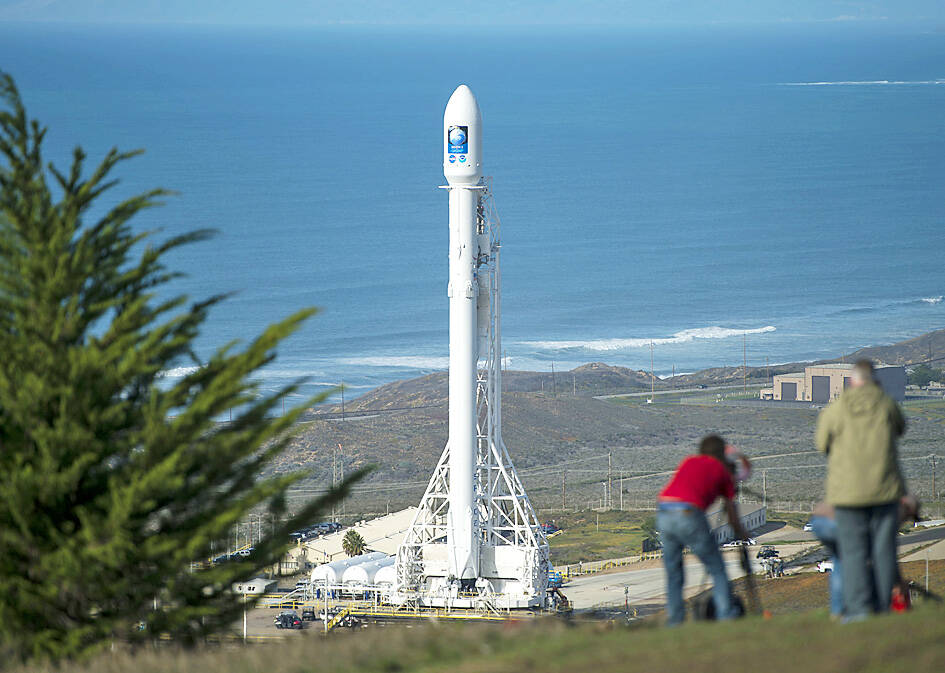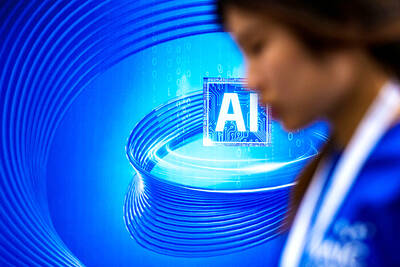Asteroid mining start-up AstroForge Inc is planning to launch its first two missions to space this year as it seeks to extract and refine metals from deep space.
The first launch, scheduled for April, is to test AstroForge’s technique for refining platinum from a sample of asteroid-like material. The second, planned for October, would scout for an asteroid near Earth to mine.
The missions are part of AstroForge’s goal of refining platinum-group metals from asteroids, with the aim of bringing down the cost of mining these metals. It also hopes to reduce the massive amount of carbon emissions that stem from mining rare Earth elements on our own planet, AstroForge CEO Matthew Gialich said in an interview.

Photo: AP
“We do our refining on site, so we are refining on the asteroid itself,” said Gialich, who previously worked at Virgin Orbit Holdings Inc and Bird Global Inc. “We are not bringing back the material back to Earth to do refining. A lot of the waste you see from these mines is in the process of refinement.”
Huntington Beach, California-based AstroForge came out of stealth mode in May last year when it announced it had raised US$13 million in seed funding, led by Initialized Capital.
The company said the October mission would be the first commercial deep-space flight outside the gravity well of Earth, excluding one previous example.
“The only other example here is Elon [Musk]’s Tesla,” Gialich said, referring to a vehicle that SpaceX Inc’s Falcon 9 rocket launched to deep space in 2018 during a test flight. “I’m not going to call that a mission because he just kind of launched it to space and then forgot about it.”
AstroForge’s first launch would send a small standardized satellite into low Earth orbit. That satellite is slated to fly as one of many payloads on one of SpaceX’s Transporter rideshare missions.
The company is planning to then launch its second craft, to scout out a previously identified near-Earth asteroid for a future mining mission. That satellite would be transported by a Space Exploration Technologies Corp rocket carrying a lunar lander from another start-up, Intuitive Machines Inc.
That flight is slated to be the second mission to the moon by Intuitive Machines; its first is set to launch as early as the first quarter of this year.
AstroForge said it plans to piggyback on the deep-space destination of the Intuitive Machines flight by sending its vehicle into lunar orbit. From there, AstroForge’s 100kg spacecraft would leave and head to the target asteroid.
AstroForge is not announcing the target, and says it will probably not do so until it is done mining the asteroid.
AstroForge’s emergence in the space industry comes a few years after the demise of an asteroid mining boom.
Two of the larger companies, Planetary Resources Inc and Deep Space Industries Inc, formed about a decade ago with the goal of mining asteroids. Neither company visited any asteroids and ultimately struggled financially. They were eventually acquired and rerouted to other endeavors.
AstroForge will also have a lot to prove to make its business work. The largest amount ever collected from an asteroid at once was 250g from NASA’s OSIRIS-REx mission, which is on its way back to Earth.
Gialich said AstroForge had learned lessons from the two earlier mining companies’ failures.
He said he had spoken with Daniel Faber, a former CEO of Deep Space Industries, to discuss how to make asteroid mining work, and that AstroForge was working with advisers from Planetary Resources on how to select asteroids for mining.
“I think the biggest differentiator here is we’ve made a lot of progress in the last 10 to 15 years since those two companies really existed ... primarily around launch,” Gialich said. “I can now buy a rideshare mission to the moon.”
Additionally, AstroForge mostly plans to outsource the infrastructure surrounding its missions.
For instance, a separate company, OrbAstro Inc, would build its spacecraft, while AstroForge would rely on companies such as SpaceX for launch.
Gialich said AstroForge is primarily focused on building out the in-space refining technology and mapping out the trajectories for the missions.
He said he ultimately hopes to bring the cost of mining platinum metals down to US$50 an ounce from about US$975 an ounce.
“This is not because we’re some great mining tech or something different,” he said. “It’s because we’re going to where the concentration of [platinum metals] is so much higher than any ore deposits we have left on Earth. And that’s what really makes the economic case for us.”
The company last year published a paper in coordination with the Colorado School of Mines highlighting the possible concentration of metals from asteroids that are available.
If all goes well with these first two flights, AstroForge plans to launch a third mission to touch down on the asteroid it has scouted, followed by a fourth mission that would attempt to land on the asteroid, extract and refine its metals, and then return to Earth.
“If everything goes right, that mission will launch in February of 2025,” Gialich said. “Which means it’s not going to launch in February of 2025, right? We all know space is really hard, because a lot of risk is involved.”

RUN IT BACK: A succesful first project working with hyperscalers to design chips encouraged MediaTek to start a second project, aiming to hit stride in 2028 MediaTek Inc (聯發科), the world’s biggest smartphone chip supplier, yesterday said it is engaging a second hyperscaler to help design artificial intelligence (AI) accelerators used in data centers following a similar project expected to generate revenue streams soon. The first AI accelerator project is to bring in US$1 billion revenue next year and several billion US dollars more in 2027, MediaTek chief executive officer Rick Tsai (蔡力行) told a virtual investor conference yesterday. The second AI accelerator project is expected to contribute to revenue beginning in 2028, Tsai said. MediaTek yesterday raised its revenue forecast for the global AI accelerator used

TEMPORARY TRUCE: China has made concessions to ease rare earth trade controls, among others, while Washington holds fire on a 100% tariff on all Chinese goods China is effectively suspending implementation of additional export controls on rare earth metals and terminating investigations targeting US companies in the semiconductor supply chain, the White House announced. The White House on Saturday issued a fact sheet outlining some details of the trade pact agreed to earlier in the week by US President Donald Trump and Chinese President Xi Jinping (習近平) that aimed to ease tensions between the world’s two largest economies. Under the deal, China is to issue general licenses valid for exports of rare earths, gallium, germanium, antimony and graphite “for the benefit of US end users and their suppliers

Dutch chipmaker Nexperia BV’s China unit yesterday said that it had established sufficient inventories of finished goods and works-in-progress, and that its supply chain remained secure and stable after its parent halted wafer supplies. The Dutch company suspended supplies of wafers to its Chinese assembly plant a week ago, calling it “a direct consequence of the local management’s recent failure to comply with the agreed contractual payment terms,” Reuters reported on Friday last week. Its China unit called Nexperia’s suspension “unilateral” and “extremely irresponsible,” adding that the Dutch parent’s claim about contractual payment was “misleading and highly deceptive,” according to a statement

The Chinese government has issued guidance requiring new data center projects that have received any state funds to only use domestically made artificial intelligence (AI) chips, two sources familiar with the matter told Reuters. In recent weeks, Chinese regulatory authorities have ordered such data centers that are less than 30 percent complete to remove all installed foreign chips, or cancel plans to purchase them, while projects in a more advanced stage would be decided on a case-by-case basis, the sources said. The move could represent one of China’s most aggressive steps yet to eliminate foreign technology from its critical infrastructure amid a